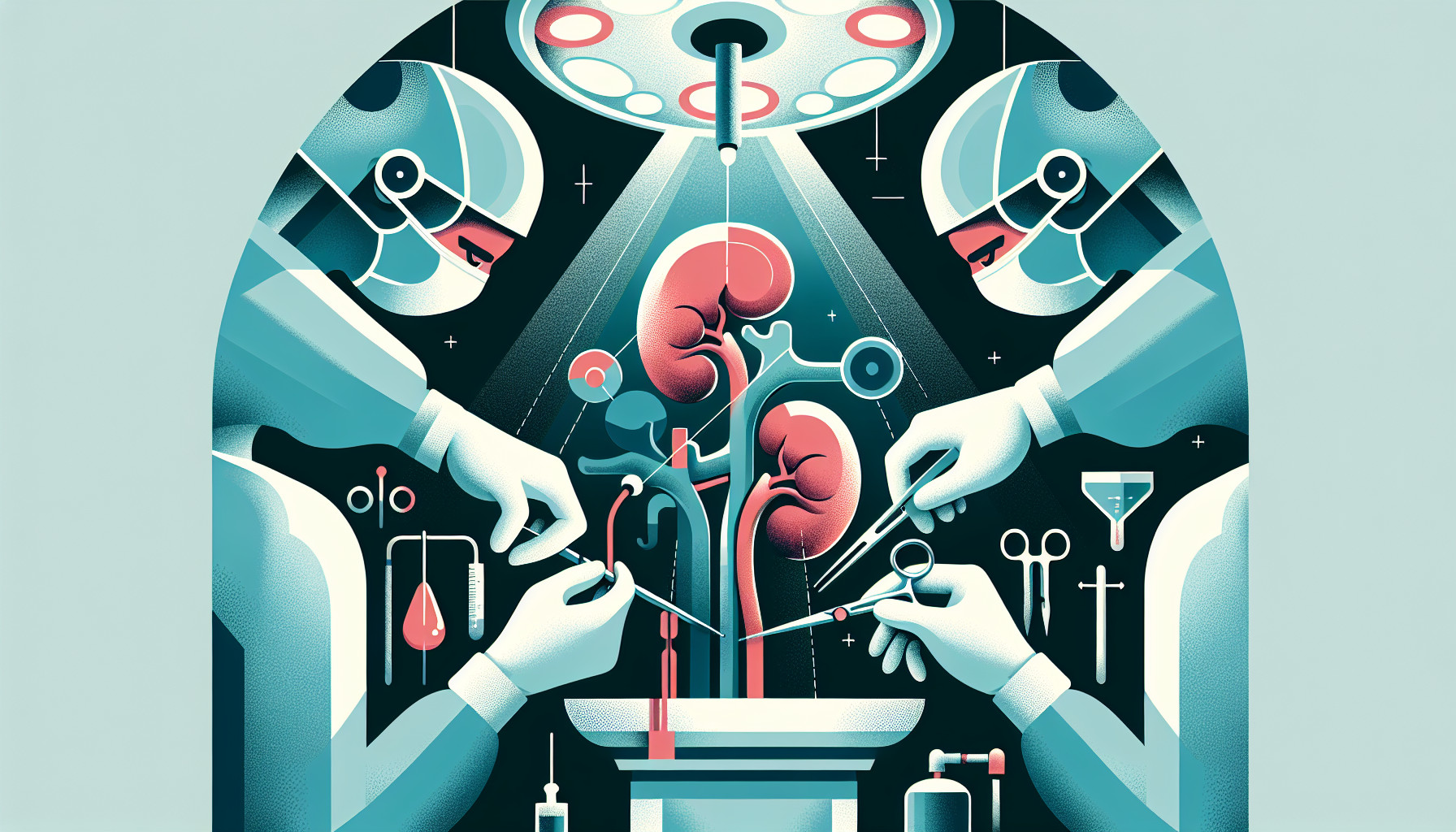Our Summary
This research paper is about a study comparing two surgical methods for removing a kidney from a living donor, known as nephrectomy. The two methods are the hand-assisted retroperitoneoscopic (HARP) and the traditional laparoscopic (TLS) techniques.
After examining data from seven studies involving 498 patients, the researchers found that the HARP technique was better than the TLS technique in terms of reducing the length of the surgery and the time the kidney was without blood supply (warm ischemia time).
However, there was no significant difference between the two methods in terms of blood loss during surgery, the length of hospital stay after surgery, and the survival rate of the transplanted kidney (graft survival). The risk of complications during surgery was also similar for both techniques.
Based on these findings, the researchers suggest using the HARP technique for kidney removal from living donors. But they also recommend more studies with a larger number of patients to further compare the safety and impact on the quality of life of the two techniques.
FAQs
- What are the two surgical methods used for kidney removal from a living donor discussed in the study?
- Which technique was found to be better in terms of reducing the surgery length and warm ischemia time?
- Was there a significant difference between the HARP and TLS techniques in terms of blood loss, hospital stay length, transplanted kidney survival rate, and risk of complications?
Doctor’s Tip
A helpful tip a doctor might tell a patient about laparoscopic nephrectomy is to ask about the specific technique being used and discuss any potential benefits or risks associated with it. Patients should also inquire about the surgeon’s experience with the chosen technique and ask about their success rates and complication rates. It is important for patients to be informed and actively involved in their treatment decisions.
Suitable For
Patients who are typically recommended for laparoscopic nephrectomy include those in need of a kidney transplant, either as a living donor or recipient. The study specifically focused on living donors, who are healthy individuals willing to donate one of their kidneys to a recipient in need. Living donor nephrectomy is preferred over deceased donor nephrectomy because it offers better outcomes for the recipient and reduces the wait time for a transplant.
In general, patients recommended for laparoscopic nephrectomy are those who are in good overall health, with no significant medical conditions that would increase the risks of surgery. They should also have a suitable anatomy for the laparoscopic approach, including sufficient space for the surgeon to maneuver and access the kidney. Additionally, patients should have realistic expectations about the risks and benefits of the procedure, as well as the recovery process.
Overall, laparoscopic nephrectomy is a safe and effective surgical option for patients in need of a kidney transplant, and the choice between the HARP and TLS techniques should be based on individual patient factors and the surgeon’s experience and preference. Further research is needed to better understand the long-term outcomes and impact on quality of life for patients undergoing laparoscopic nephrectomy.
Timeline
Before laparoscopic nephrectomy, a patient will typically undergo a series of tests and evaluations to determine their eligibility for surgery. This may include blood tests, imaging studies, and consultations with various healthcare providers. The patient will also be instructed on pre-operative preparations, such as fasting before surgery and avoiding certain medications.
On the day of the surgery, the patient will be given anesthesia and taken to the operating room. During the laparoscopic nephrectomy procedure, small incisions are made in the abdomen, through which a laparoscope and other surgical instruments are inserted. The surgeon then removes the kidney using the chosen technique, whether it be HARP or TLS.
After the surgery, the patient will be monitored closely in the recovery area before being transferred to a hospital room. They may experience pain, discomfort, and fatigue in the days following surgery. Pain medication and instructions for post-operative care will be provided to help manage these symptoms.
Over the next few weeks, the patient will have follow-up appointments with their healthcare team to monitor their recovery and ensure that the remaining kidney is functioning properly. They will also be advised on lifestyle changes, such as diet and exercise, to promote overall kidney health.
Overall, laparoscopic nephrectomy offers a minimally invasive approach to removing a kidney from a living donor, with potential benefits in terms of shorter surgery time and warm ischemia time. However, further research is needed to fully understand the long-term outcomes and safety of the HARP and TLS techniques.
What to Ask Your Doctor
Some questions a patient should ask their doctor about laparoscopic nephrectomy include:
- What are the benefits of laparoscopic nephrectomy compared to traditional open surgery?
- What are the potential risks and complications associated with laparoscopic nephrectomy?
- How long will the surgery take, and what is the expected recovery time?
- How does the warm ischemia time compare between laparoscopic nephrectomy and other surgical techniques?
- Will I need to stay in the hospital after the surgery, and if so, for how long?
- What is the success rate of laparoscopic nephrectomy in terms of kidney transplant outcomes?
- How experienced are you in performing laparoscopic nephrectomy, and what is your success rate with this technique?
- Are there any specific lifestyle changes or precautions I should take before or after the surgery?
- What is the follow-up care plan after the surgery?
- Are there any ongoing clinical trials or research studies comparing different surgical techniques for nephrectomy that I should be aware of?
Reference
Authors: Elmaraezy A, Abushouk AI, Kamel M, Negida A, Naser O. Journal: Int J Surg. 2017 Apr;40:83-90. doi: 10.1016/j.ijsu.2017.02.018. Epub 2017 Feb 17. PMID: 28216391
